From the vine cutting to the first drop of wine poured into a glass, the wine travels a long way being blessed by the scorching heat and the cold, the rain and the wind, the richness of the soil and the cracked hands of its gatherers

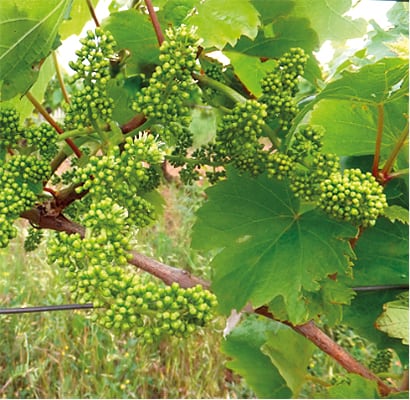
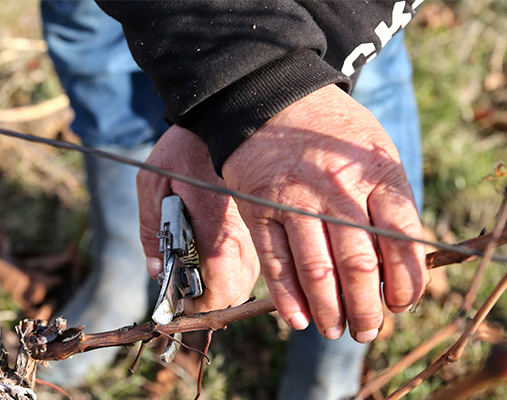
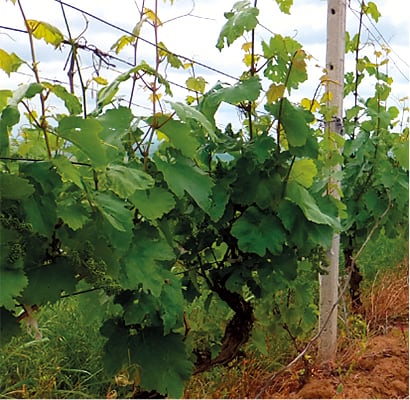

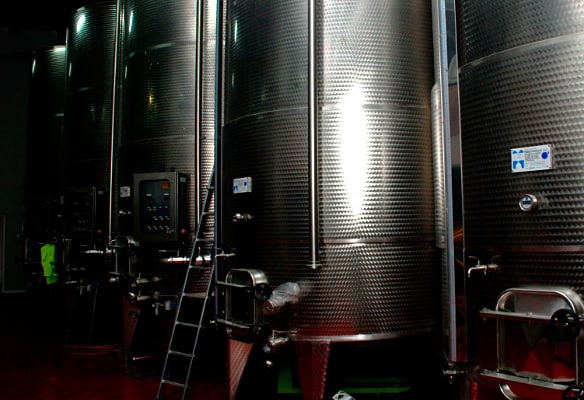
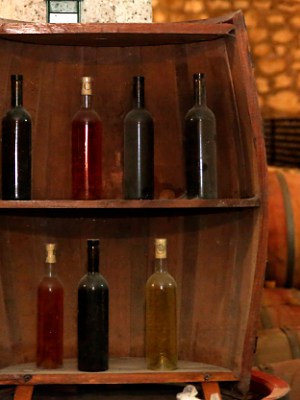

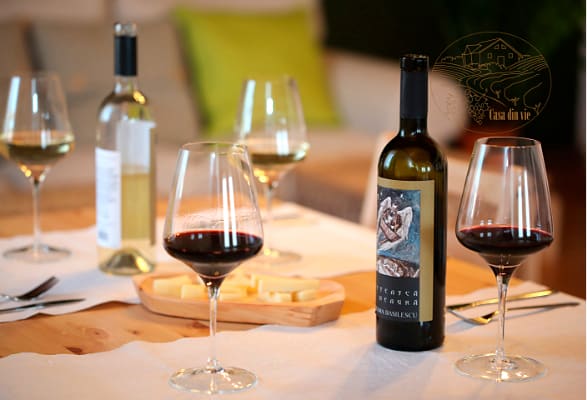

Work in the vineyard
First step in the wine journey
Vineyard workers are engaged 12 months a year in looking after over 400 000 grape-vine scions, that stretch over 100 ha (60 ha in Urlaţi and 40 ha in Pietroasa). It is hard work, which must be done whatever the climatic conditions: sun, wind, rain, cold. Each grape-vine scion is being taken care of from the moment it is planted to the beginning of its abatement.
Throughout the year, there are various activities in the vineyard, starting with the fructification cutting and ending with preparation for hibernation. During the early months of the year, in the vineyard take place the fructification cuttings, supporting system appraisal, and others. Working in the vineyard attains its peak in the spring, with the pruning or binding of the vines and offshoot weeding. Afterwards, during summer, work is continued with tending of the sprouts, phytosanitary treatments, norming the number of grape-clusters on each vine, weeding, vine manoeuvring.
The end of the summer in the vineyard is marked by the entrance of the grapes in mellowness; red wine grape varieties start to catch colour through accumulation of anthocyanin, while wine grape varieties start becoming pellucid. At this moment grape samplings begin in order for a physico-chemical analysis to be done to determine the unfolding of the ripening and implicitly the beginning of the ingathering.
First step in the wine journey
Vineyard workers are engaged 12 months a year in looking after over 400 000 grape-vine scions, that stretch over 100 ha (60 ha in Urlaţi and 40 ha in Pietroasa). It is hard work, which must be done whatever the climatic conditions: sun, wind, rain, cold. Each grape-vine scion is being taken care of from the moment it is planted to the beginning of its abatement.
Throughout the year, there are various activities in the vineyard, starting with the fructification cutting and ending with preparation for hibernation. During the early months of the year, in the vineyard take place the fructification cuttings, supporting system appraisal, and others. Working in the vineyard attains its peak in the spring, with the pruning or binding of the vines and offshoot weeding. Afterwards, during summer, work is continued with tending of the sprouts, phytosanitary treatments, norming the number of grape-clusters on each vine, weeding, vine manoeuvring.
The end of the summer in the vineyard is marked by the entrance of the grapes in mellowness; red wine grape varieties start to catch colour through accumulation of anthocyanin, while wine grape varieties start becoming pellucid. At this moment grape samplings begin in order for a physico-chemical analysis to be done to determine the unfolding of the ripening and implicitly the beginning of the ingathering.


Vineyard Harvesting
Towards sweetness do the grapes ripen under the sun, on the vine. To bring plunders to a halt, we see no watchman, And the rosy cluster, pearl by pearl to reap, Do not withstand then, sweetheart: it is theirs autumn’s gift. Yield by your own resolve, for my arm to take you in!
Ion Pillat, At the vineyard harvesting
Harvesting of the vineyard is as important as the whole technological wine-making process. Depending on grape variety and viticultural habitat, the grapes arrive at full-growth in different “epochs”, meaning different periods of summer-autumn season. Experts talk about physiological maturity – when grape seeds are ripe and easily detach from the pulp – and technological maturity determined by grape composition necessary to obtain a certain kind of wine. White wine grape variety ripen first, followed by red grape, although depending on the type of wine chosen by the oenologist for production, white and red grape harvesting may come-next-after repeatedly. For example, red grapes used for rosé wines (higher acidity and more fruitful flavours) may be harvested before white grapes used for medium and sweet white wines.
This is the phase in which the winegrower and oenologist carefully follow the unfolding of grape ripening in order to choose the best moment of harvesting. At Basilescu Winery, the harvesting is done only manually, by harvesters instructed to choose only healthy grapes, which are collected in coffrets of 18 kg tops in order not to be crushed and oxidise on their way to the winery.
Towards sweetness do the grapes ripen under the sun, on the vine. To bring plunders to a halt, we see no watchman, And the rosy cluster, pearl by pearl to reap, Do not withstand then, sweetheart: it is theirs autumn’s gift. Yield by your own resolve, for my arm to take you in!
Ion Pillat, At the vineyard harvesting
Harvesting of the vineyard is as important as the whole technological wine-making process. Depending on grape variety and viticultural habitat, the grapes arrive at full-growth in different “epochs”, meaning different periods of summer-autumn season. Experts talk about physiological maturity – when grape seeds are ripe and easily detach from the pulp – and technological maturity determined by grape composition necessary to obtain a certain kind of wine. White wine grape variety ripen first, followed by red grape, although depending on the type of wine chosen by the oenologist for production, white and red grape harvesting may come-next-after repeatedly. For example, red grapes used for rosé wines (higher acidity and more fruitful flavours) may be harvested before white grapes used for medium and sweet white wines.
This is the phase in which the winegrower and oenologist carefully follow the unfolding of grape ripening in order to choose the best moment of harvesting. At Basilescu Winery, the harvesting is done only manually, by harvesters instructed to choose only healthy grapes, which are collected in coffrets of 18 kg tops in order not to be crushed and oxidise on their way to the winery.


Fermentation
Genesis of wine
The finest grapes, carefully selected from the vineyard, as well as at the picking belt, will continue their journey to the fermentation vessels, yet not before destemming, in order to avoid a grassy taste from green clusters.
Alcoholic fermentation is the first step in wine production and it is done by selected yeasts. These transform the sugar from grape crush into alcohol. For white wines, only the fermentation of the grape crush after the grape pressing takes place. For flavoured and red wines, a macer-fermentation is needed, which means a fermentation in the presence of grapes, especially their peel, from which the flavours and colour of the wines are extracted. The duration of the maceration is of a few hours for flavoured varieties (Busuioacă de Bohotin and Tamaioasa Romaneasca) and of a few days for red varieties.
For the alcoholic fermentation, Basilescu Winery possesses stainless vessels with automated temperature control which guarantees a thorough control over the process. Why is this important? That is because the fresh, fruitful flavours is a lot better maintained if the alcoholic fermentation takes place at low and constant temperatures. The alcoholic fermentation phase represents the genesis of the wine, which is why it is carefully monitored through tests and analysis.
Immediately after the alcoholic fermentation, the wine fining takes place, which is done naturally, using only the gravitational force. On the bottom of the vessels larger particles are deposited, remnants of grapes after the pressing, as well as the lees and some molecules with vegetal origins which, due to changes in the composition of the liquid, lose their solubility and precipitates (for example: the tartaric acid – an acid with vegetal origins, specific to fruits, especially grapes). This process can take a few weeks (depending on the turbidity of the grape crush and the total volume of the liquid), which is why only a few coagulant substances are used, of mineral or organic origins (clay, fish oil, gelatin, egg-white, etc.) in order to increase the precipitation speed of the particles and their deposition. This phase is followed by the extraction of the wine left on top of the deposition and its filtration.
Genesis of wine
The finest grapes, carefully selected from the vineyard, as well as at the picking belt, will continue their journey to the fermentation vessels, yet not before destemming, in order to avoid a grassy taste from green clusters.
Alcoholic fermentation is the first step in wine production and it is done by selected yeasts. These transform the sugar from grape crush into alcohol. For white wines, only the fermentation of the grape crush after the grape pressing takes place. For flavoured and red wines, a macer-fermentation is needed, which means a fermentation in the presence of grapes, especially their peel, from which the flavours and colour of the wines are extracted. The duration of the maceration is of a few hours for flavoured varieties (Busuioacă de Bohotin and Tamaioasa Romaneasca) and of a few days for red varieties.
For the alcoholic fermentation, Basilescu Winery possesses stainless vessels with automated temperature control which guarantees a thorough control over the process. Why is this important? That is because the fresh, fruitful flavours is a lot better maintained if the alcoholic fermentation takes place at low and constant temperatures. The alcoholic fermentation phase represents the genesis of the wine, which is why it is carefully monitored through tests and analysis.
Immediately after the alcoholic fermentation, the wine fining takes place, which is done naturally, using only the gravitational force. On the bottom of the vessels larger particles are deposited, remnants of grapes after the pressing, as well as the lees and some molecules with vegetal origins which, due to changes in the composition of the liquid, lose their solubility and precipitates (for example: the tartaric acid – an acid with vegetal origins, specific to fruits, especially grapes). This process can take a few weeks (depending on the turbidity of the grape crush and the total volume of the liquid), which is why only a few coagulant substances are used, of mineral or organic origins (clay, fish oil, gelatin, egg-white, etc.) in order to increase the precipitation speed of the particles and their deposition. This phase is followed by the extraction of the wine left on top of the deposition and its filtration.


Wine Blending
The art of wine
Wine blending is the craftsmanship of the oenologist, to create unique wines. Creation wines are obtained through blending wines from different years and/or different varieties.
Younger wines present a certain fruitfulness, while older wines have more complex flavours acquired over the ageing period in oak barrels. Younger wines are a bit more crisp, with a refreshing acidity during every swallow, while older wines are more balanced, rounded as if by the wisdom of the years that passed by. Each of these are like pieces of a puzzle which completes the final depiction, in order to offer us an unforgettable experience.
The art of wine
Wine blending is the craftsmanship of the oenologist, to create unique wines. Creation wines are obtained through blending wines from different years and/or different varieties.
Younger wines present a certain fruitfulness, while older wines have more complex flavours acquired over the ageing period in oak barrels. Younger wines are a bit more crisp, with a refreshing acidity during every swallow, while older wines are more balanced, rounded as if by the wisdom of the years that passed by. Each of these are like pieces of a puzzle which completes the final depiction, in order to offer us an unforgettable experience.


Ageing
Wine wisdom
This is the conclusion of the entire activity, starting with the work done in the vineyard and ending with ageing of the wine. It appears on the stage, under the spotlights, with simplicity, overflowing elegance and mystery.
Wine ageing is the phase in which wines develop a distinct complexity, dependant on the potential offered by the quality of the grapes, yet, unmistakably, dependant on the technology and the use or not of oak barrels as well.
The type and quality of the wine will dictate the ageing period which can vary between 6 and 24 months. We use French and Romanian oak wood barrels which best ennobles our wine made from international and native varieties. There is a certain particular affinity between wine and oak barrels and between the origins of the grape variety and of the oak wood. The latter potentiate the complexity of the “fermented grape juice” having the propensity to transform it into a mysterious bacchic potion, emphasizing it’s intensity and persistence.
Wine will receive all the commendation of the public at the end of the play – when the last pearl of this magical potion is savoured by our customers!
Wine wisdom
This is the conclusion of the entire activity, starting with the work done in the vineyard and ending with ageing of the wine. It appears on the stage, under the spotlights, with simplicity, overflowing elegance and mystery.
Wine ageing is the phase in which wines develop a distinct complexity, dependant on the potential offered by the quality of the grapes, yet, unmistakably, dependant on the technology and the use or not of oak barrels as well.
The type and quality of the wine will dictate the ageing period which can vary between 6 and 24 months. We use French and Romanian oak wood barrels which best ennobles our wine made from international and native varieties. There is a certain particular affinity between wine and oak barrels and between the origins of the grape variety and of the oak wood. The latter potentiate the complexity of the “fermented grape juice” having the propensity to transform it into a mysterious bacchic potion, emphasizing it’s intensity and persistence.
Wine will receive all the commendation of the public at the end of the play – when the last pearl of this magical potion is savoured by our customers!

 Let us celebrate events with wine and beautiful words
Let us celebrate events with wine and beautiful words
Plautus

Explore our wine collection
GDPR
Pentru noi, confidențialitatea dvs. este importantă
Noi și partenerii noștri utilizăm tehnologii, cum ar fi modulele cookie, și vă procesăm datele cu caracter personal, precum adresele IP și identificatorii cookie, pentru a personaliza anunțurile publicitare și conținutul în funcție de interesele dvs., pentru a măsura eficiența anunțurilor și a conținutului și pentru a obține informații despre publicul care a văzut anunțurile și conținutul.
Faceți clic mai jos pentru a vă da consimțământul privind utilizarea acestei tehnologii și procesarea datelor dvs. cu caracter personal în aceste scopuri.
Da, am înțeles